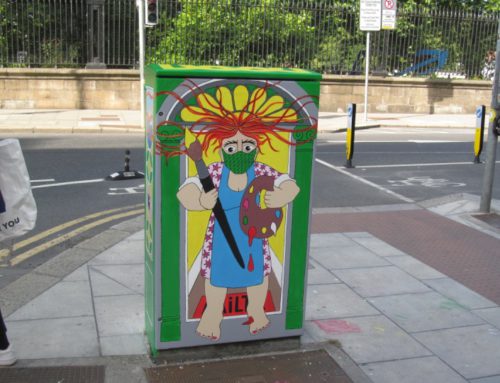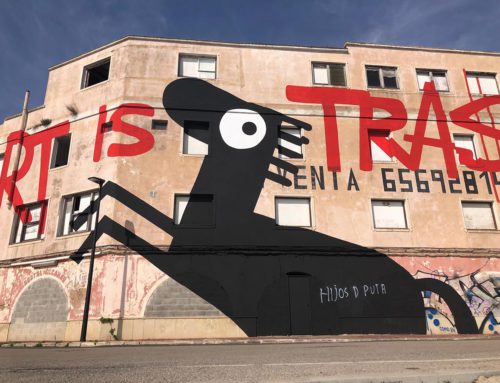Ai Weiwei (2011) – ‘My definition of art has always been the same. It is about freedom of expression, a new way of communication. It is never about exhibiting in museums or about hanging it on the wall. Art should live in the heart of the people. Ordinary people should have the same ability to understand art as anybody else. I don’t think art is elite or mysterious. I don’t think anyone can separate art from politics. The intention to separate art from politics is itself a very political intention’
So does art have the capacity to offer an alternative way of thinking to the dominant western social, political and economic order that is neoliberal democracy? The answer to this question I believe is to be found somewhere between the fields of art and politics. There are many terms used which encompass the genre of Art activism such as Critical Art, Socially Engaged Art, Social Practice Art, Artivism, Political Art and forms of both Participatory and Collaborative Art.
Art activism is a form of art that overtly aspires to effect change in the prevailing social and political order. For change to happen it must take place outside of the existing established order and institutions otherwise any attempt to change will in itself be appropriated by the establishment. It takes the form of collective acts with the public as its medium.
Contemporary art has moved away from the formalism of the twentieth century where real innovative success lay in the development of a new genre that displaced conventions of tradition.
Contemporary art now looks to displace instead the structures and system of the society in which it exists, the rules that determine what is appropriate in the way that we relate to each other.
Contemporary art activism is according to Allan Sekula characterised by the following features:
- There is a connection between real communities and cyber-communities;
- It is anti-capitalist /anti-neo liberalism and their intangibilities;
- It is carnivalesque in nature and aesthetic.
The Zapatista movement has strongly influenced contemporary art activism since the 1990s. In 1994 the Zapatista Army of National Liberation movement of the Mexican Chiapas province emerged demanding autonomy. They broadcast their message in a media savvy way that was fresh and interesting, and drew unprecedented international support. They approached their objective through the use of the internet and social networking culture with a poetic and exciting carnivalesque flavour to their activities. The Zapatista movement is characterised by the organising of dances, rock concerts, poetry sessions and sports tournaments. The movement ritualises ‘alegria’ (joy) through celebrations which inspires participation. Zapatista communications captured the imaginations of many, internationally.
Lieven De Cauter in Art and Activism in the Age of Globalisation talks about ‘subversion’ and distinguishing ‘subversivity’ from political subversion. Rather than overthrowing the system as political subversion aims to do subversivity is a ‘disruptive attitude that tries to create openings, possibilities in the ‘closedness’ of a system’. Subversivity questions rigid belief systems. Subversivity is eccentricity, a desire to break away from conformity and convention disrupting the tradition. Subversivity does not necessarily want to overthrow the system but it has an aversion to consensus. It is not revolutionary thinking but seeks temporary disruptions.
De Cauter maintains that we seem to have lost any desire to negate or criticise and that we are witnessing the end of a tradition of dissent. That even the youth and subcultures have not surfaced since punk.
Chantal Mouffe, a Belgian political theorist, advocates the collaborative approach of artists’ ‘engagement with’ the art institution. Her argument is that change must come from within the existing hegemonic order of the art institution. She sees critical art as a way that artistic practices can “contribute to the unsettling of the existing hegemony”. She is also sceptical about demonstration without structures, pointing to the success of the Indignado protests in Spain and how they undermined the Socialist Party only to let in the right wing. She would have preferred collaboration with appropriate political parties.
Mouffe uses the Museu D’Art Contemporani De Barcelona (MACBA) in Spain as an example of how engagement with the art institution by art activists can successfully change the hegemonic order of the art institution.
But close research suggests even here the experience was negative and the depressing denouement covered up.
MACBA opened in November 1995 in the Raval district of Barcelona. In order to build the institution, an area of the Raval district was cleared and a number of residents were relocated. The Raval, once a traditional working class area of the city has since gone through a process of gentrification
The civil demonstrations and protests in Seattle in 1999 sought to confront neo-liberalism and much of this happened through performance and activist art. The impact of the ‘Battle for Seattle’ spread across the world. MACBA wanted to create a network of social groups that would become a part of the anti-globalisation movement.
In the spring of 1999 MACBA made contact with the art activist collective Fiambrera Obrera, which had been active in Seville and Madrid throughout the 1990s, proposing that they organise a workshop at MACBA to which they would invite various well known and respected art activists groups, such as ‘Reclaim the Streets’, from around Europe to collaborate in a project called ‘’Direct Action as one of the Fine Arts’’. MACBA’s original idea was, according to the Fiambreras, to hold a ‘classic museum-workshop’ where small groups of up to thirty people would be charged an entrance fee and would then sit around and discuss particular subjects around art and activism.
The Fiambreras declined MACBA’s invitation initially responding that this was not ‘their model’. In fact they didn’t have a ‘model’ at all but they saw an opportunity to create one in the MACBA invitation. The Fiambreras told MACBA that they were not in favour of inviting a handful of famous art activists from around Europe to spend a few days in Barcelona – the Fiambreras’ vision was to create functioning teams of people who were capable of establishing real working relationships with the already existing groups of activists working in Barcelona.
The management of MACBA accepted this proposal and gave the Fiambreras the resources but also the autonomy to get on with the project. The Fiambreras spent the summer of 1999 introducing and connecting the visiting art activists with the corresponding local activist groups in Barcelona.
Workshops were organised into five main areas of work. They were:
- Underemployment and precarious labour;
- Border and migrations;
- Property speculation and gent-rification;
- Media and new independent autonomous communication networks;
- Empowerment, ‘agency’ and policies of direct action.
The workshops had exciting international collaborators such as the group Ne Pas Plier from Paris, known for their innovative communication through design . This group collaborated with the underemployed and unemployed workshop to start a new local publication in Barcelona – Kein Mensch ist illegal (No one is illegal). Members joined a debate on the rights of illegal immigrants which culminated in Border Camps being set up in the South of Spain in 2001.
Fiambrera Obrera co-ordinated the property speculation and gentrification workshop and worked with the ‘Reclaim the Streets’ group known for their carnivalesque interventions in public spaces in England.
The media was a strong theme throughout. The media workshop worked with ‘RTMark’ (later to become the Yes Men) who infiltrated malfeasant companies’ public meetings. The influence of the RTMark particular style of tactical embarrassment by the distortion of corporate communication strategies became fully absorbed into the modus operandi of Spanish art activism.
The workshops posed challenges for the participants and art activist collaborators as well as for the museum. There was a clash of values for many people who supported the Barcelona squatter movement (Okupas) to find themselves working with MACBA which was for many a symbol of property speculation in Barcelona. This meant that events and meetings often had to take place off site. There were difficulties for the museum management concerning health and safety, as the participants got keys cut to MACBA premises and distributed them amongst themselves without permission.
By the end of the Year 2000 the art activist collective ‘Las Agencias’ (Agencies) was formed as a result of the workshops . It was a broad collaborative network of professional and amateur artists and graphic designers.
In the spring of 2001 the media began to report that MACBA was financing and organising workshops on ‘civil disobedience’ as part of the anti-globalisation movement. It was also reported in the media that there were plans afoot to confront the police with ‘some sort of special clothing and with shields’. The police investigated the activities of Las Agencias and concluded that it was not possible to distinguish between the ‘artists’ and the militants of the anti-globalisation movement. Tensions were building.
The World Bank Summit which was scheduled to take place in Barcelona in July 2001 was dramatically cancelled by the organisers due to fears of a violent protest in the city. There had already been anti-globalisation demonstrations in Prague and Gothenburg that summer. It was decided by the ‘assembly’ which consisted of the management of MACBA and Las Agencias, that the counter-summit was to go ahead anyway in Barcelona.
Las Agencias organised an anti-globalisation demonstration for June 24, 2001 in the centre of Barcelona.
The atmosphere was carnivalesque with 500,000 people on the streets many wearing the ‘Pret a Revolter’ costumes designed by Las Agencias. There was a police charge generating complete chaos as people were arrested and detained. The police destroyed the bar at MACBA and they smashed the glass of the main door of the museum. Rubber bullets were fired. MACBA had been getting lots of complaints from the local government (ayuntamiento) and Mayor Clos of Barcelona who were all asking “what the f*** are you doing with our money?”
The right wing was fighting back.
Las Agenicas and MACBA had meetings once a week – assemblies – where the group and the Director would meet and talk about what money would go to each project. MACBA dealt with the group never with individuals.
Later in the summer of 2001 MACBA came back to Las Agencias with suggestions about how to continue the collaboration – that would have meant the activists losing autonomy. Even though the project officially was to continue until October, MACBA started to make things difficult for Las Agencias. They couldn’t work at night time, only one or two people could have the key to the building, there was a private security guard at the door, clearly with the intention of making them leave.
Las Agencias subsisted for a while but with a much smaller group, in a rented space and with no budget to work with. The Fiambreras from Madrid stayed in contact with Las Agencias and worked with them on projects such as YOMANGO etc.
The result of this experience has been that in general Spanish art activism is now practised at a ‘necessary distance’ from state institutions.
There is very little material or information in the MACBA archives in Barcelona to describe the events of 2001 and Las Agencias activities and collaboration with the Institution. The archivist at MACBA, Estel Fabregat, told me that all other projects at MACBA have been meticulously archived and written about extensively and she expressed surprise that there was so little about Las Agencias and in particular about how the relationship between the institute and Las Agencias ended. She described the Las Agencias project as ‘delicate’. There is also no mention of the Las Agencias project on the MACBA website either while information on all other projects can be found there.
The CEO of MACBA between 1997 and 2002, an American citizen called John Zvereff, wrote a letter in 2010 to the current Director of MACBA Bartomeu Mari. This letter has perhaps unintentionally found its way into the archives at MACBA. It describes the experience with Las Agencias as ‘disastrous’ and says the project was ‘‘at one point about to cost Jorge his job’’ (presumably referring to Jorge Ribalta Director of Public Programmes at MACBA). Zvereff goes on to say in this letter that in his opinion the movement “lost its meaning once it was given a home and resources when it was its very mobility and creation of fund raising strategies which defined it’’.
Zvereff describes the end of the relationship between MACBA and Las Agencias as a ‘nightmare’ which he found himself having to clean up. All of the management of MACBA surprisingly did in fact keep their jobs but Las Agencias was the sacrificial lamb. MACBA went on to work with some art activist collectives after 2001 but on a far more restrictive basis. Many of those involved in Las Agencias refused to work with MACBA in any capacity again.
MACBA went on in the autumn of 2003 to set up a collaboration network with anti-Forum movements along the same model as Las Agencias but far more controlled centrally by the museum. This collaboration was what MACBA called “a temporary public counter-sphere in the context of a city subject to an all-pervading institutional propaganda machine”.
The collaboration was a failure, despite the involvement of excellent people, despite the fact that Catalan regional governance allowed MACBA unusual autonomy, despite the fact that Catalonia has a long tradition of a politicised social groups making the public open to participation in activities by art activists, and despite the timing – in 1999-2003 when the anti-globalisation movement was at its peak.
After the events of 2001 a new artist collective called Enmedio formed in Barcelona with a new approach. The new collective does not work with any institutions directly and keeps what one member of Enmedio called a “necessary distance”. It is this distance, withdrawal or “exodus” from the art institution which makes the existence of the collective possible and its success viable.
Barcelona fifteen years ago was a cockpit of art activism and clear lessons are evoked. Mouffe’s theory that collaboration worked there – and so will work elsewhere – does not stand up. If Irish artists are serious about change they must protest through their work, but maintain their independence.






Leave A Comment